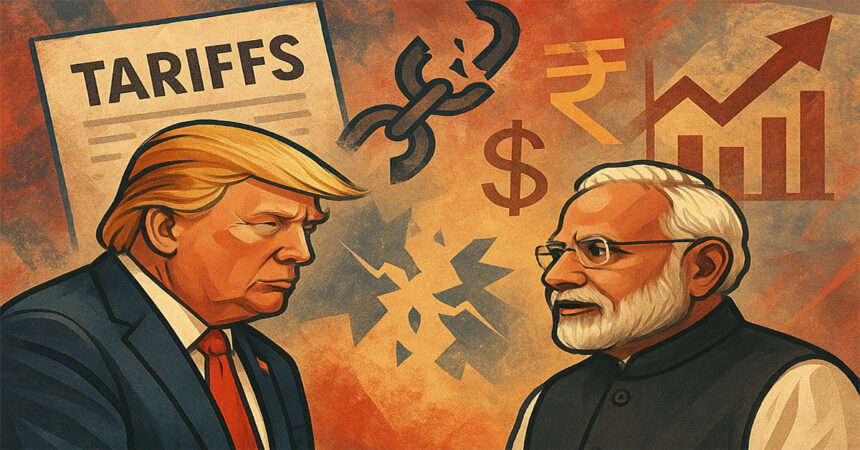The escalating trade war between the United States and India has reached a critical juncture in August 2025, as President Donald Trump imposed a punitive 25% tariff on Indian exports worth $87 billion annually. This aggressive trade stance, coupled with additional penalties targeting India’s energy purchases from Russia, marks one of the most significant bilateral trade disputes in recent history.
Understanding Trump’s Tariff Strategy Against India
The current Trump tariffs on India represent a dramatic escalation from previous trade negotiations. On July 30, 2025, President Trump announced the implementation of a 25% baseline tariff on all Indian imports, effective from August 1, 2025. This decision came after months of stalled bilateral trade negotiations and represents the highest tariff rate imposed on any major Asian economy except China.
Read More : Legendary Tribal Leader Shibu Soren, JMM Founder and Former Jharkhand CM, Passes Away at 81
Key Components of the Tariff Structure
The US tariff framework targeting India consists of multiple layers:
In comparison, India’s competitors face significantly lower rates: Pakistan (19%), Vietnam (20%), Bangladesh (18%), and Japan/South Korea (15%).

The Russian Oil Connection: Trump’s Primary Justification
President Trump’s primary justification for the Trump tariffs on India centers on New Delhi’s continued energy imports from Russia. India currently imports approximately 1.7 million barrels of Russian oil daily, accounting for 40% of its total crude imports. This relationship developed after traditional Middle Eastern suppliers redirected oil to Europe following the Ukraine conflict.

Read More : Meet the All-New 2026 BMW F 450 GS: Bold Design, Full Specs & Adventure-Ready Power
Trump’s Accusations and Threats
In a series of inflammatory statements, Trump accused India of “fueling the war machine” and profiting from Russian oil sales. On August 4, 2025, he threatened to “substantially” raise tariffs beyond the existing 25% within 24 hours. Trump’s Truth Social post stated: “India is not only buying massive amounts of Russian Oil, they are then, for much of the Oil purchased, selling it on the Open Market for big profits”.
India’s Comprehensive Response Strategy
India’s response to the Trump tariffs on India has been multifaceted, combining diplomatic pushback with economic countermeasures. The Ministry of External Affairs issued an unprecedented six-point rebuttal, marking one of the strongest diplomatic responses in recent bilateral history.
India’s Official Position
The Indian government’s response emphasized several key points:
- Energy Security Priority: India’s oil imports are “a necessity compelled by the global market situation”
- Western Hypocrisy: The US and EU continue trading with Russia in uranium, fertilizers, and chemicals
- Economic Autonomy: India will “take all necessary measures to safeguard its national interests”
- Historical Context: The US initially encouraged Indian purchases of Russian oil to stabilize global energy markets
Read More : Trump’s Statement on India’s “Dead Economy”: Understanding the Context and Implications
Retaliatory Measures at WTO
India has initiated formal retaliation through the World Trade Organization, proposing counter-duties on US goods. The retaliatory framework targets:
- Steel and Aluminum Products: Equivalent duties to match $1.91 billion in US collections
- Automobile Components: Counter-tariffs on $2.895 billion worth of US auto imports
- Selected Consumer Goods: Strategic targeting of politically sensitive US exports
Trump tariffs on India Economic Impact Analysis: GDP and Export Projections
The Trump tariffs on India are expected to significantly impact India’s economic growth trajectory. Multiple rating agencies have revised their forecasts downward following the tariff announcement.
Read More : Shah Rukh Khan’s Historic National Film Award and Full Winners’ List
GDP Growth Revisions
| Agency | Previous Forecast | Revised Forecast | Impact |
|---|---|---|---|
| ICRA | 6.2% | 6.0% | -20 basis points |
| Nomura | 6.4% | 6.2% | -20 basis points |
| Barclays | Baseline | -30 basis points | -30 basis points |
Sectoral Impact Assessment
The tariffs will disproportionately affect specific export sectors:
Most Vulnerable Sectors:
- Textiles and Garments
- Gems and Jewelry (Cut and Polished Diamonds)
- Auto Components
- Chemicals and Dyes
- Leather Goods
Relatively Protected Sectors:
- Pharmaceuticals (37% of US exports)
- Petroleum Products
- Telecom Equipment

Read More : Hindu Terrorism Debate: Examining Amit Shah’s Statement
India’s ₹20,000 Crore Export Promotion Mission
In response to the Trump tariffs on India, the government announced an ambitious ₹20,000 crore Export Promotion Mission scheduled for implementation by September 2025. This comprehensive initiative represents one of India’s largest trade support packages.
Trump tariffs on India Mission Components
The Export Promotion Mission encompasses five strategic pillars:
- Trade Finance: Collateral-free loans for MSME exporters
- Regulatory Support: Addressing non-tariff barriers in international markets
- Brand India Enhancement: Global positioning similar to Japan, Korea, and Switzerland
- E-commerce Hubs: Digital trade infrastructure development
- Trade Facilitation: Streamlined logistics and warehousing solutions
Read More : Blockbuster Bonanza: Must-Watch Movies Releasing in India, August 2025
Historical Context: US-India Trade Relationship
The current tariff dispute represents a significant departure from the traditionally growing US-India economic relationship. Bilateral trade reached $191.54 billion in 2022, with the US maintaining a consistent trade deficit.
Trump tariffs on India Trade Balance Evolution
US-India trade dynamics have evolved significantly over the past decade:
- 2024 Total Trade: $212.3 billion
- US Exports to India: $41.5 billion
- US Imports from India: $87.3 billion
- Trade Deficit: $45.8 billion (5.9% increase from 2023)
Read More : The Safest Family Vehicle for 2025
Trump tariffs on India Global Strategic Implications
The Trump tariffs on India extend beyond bilateral trade, potentially reshaping regional geopolitical alignments. India’s firm stance against US pressure demonstrates its commitment to strategic autonomy, potentially strengthening ties with alternative partners.
Trump tariffs on India Regional Competitive Dynamics
The tariff structure creates competitive advantages for India’s regional rivals:
- Vietnam: 5 percentage points lower tariffs
- Bangladesh: 7 percentage points advantage
- Indonesia: 6 percentage points benefit
- Pakistan: 6 percentage points preferential treatment
Future Prospects and Negotiations
Despite the current tensions, both countries continue diplomatic engagement. The next round of US-India trade talks is scheduled for late August 2025. However, the fundamental disagreement over India’s Russia relationship and agricultural market access remains unresolved.
Potential Resolution Pathways
Industry experts identify several potential compromise areas:
- Limited Dairy Market Opening: Conditional access for specific US dairy products
- Defense Procurement Increases: Enhanced military equipment purchases
- Energy Diversification: Gradual reduction in Russian oil dependency
- Agricultural Concessions: Selective market access for US farm products
Read More : Latest Scientific Research on the Effect of Alcohol on Health
Conclusion: Navigating Uncertain Waters
The Trump tariffs on India represent a watershed moment in US-India relations, testing the resilience of a partnership built over two decades. India’s resolute response, combining diplomatic firmness with economic countermeasures, signals its determination to maintain strategic autonomy while protecting national interests.
The ultimate resolution will likely require compromise from both sides, balancing America’s geopolitical objectives with India’s economic imperatives. As both nations prepare for continued negotiations, the global trade community watches closely, understanding that the outcome will influence international trade patterns and strategic alignments for years to come.
The current standoff underscores the complexity of modern trade relationships, where economic interests intersect with geopolitical considerations. For India, successfully navigating this challenge while maintaining its growth trajectory will require careful diplomatic maneuvering and robust domestic policy support through initiatives like the Export Promotion Mission.
External Resources:








